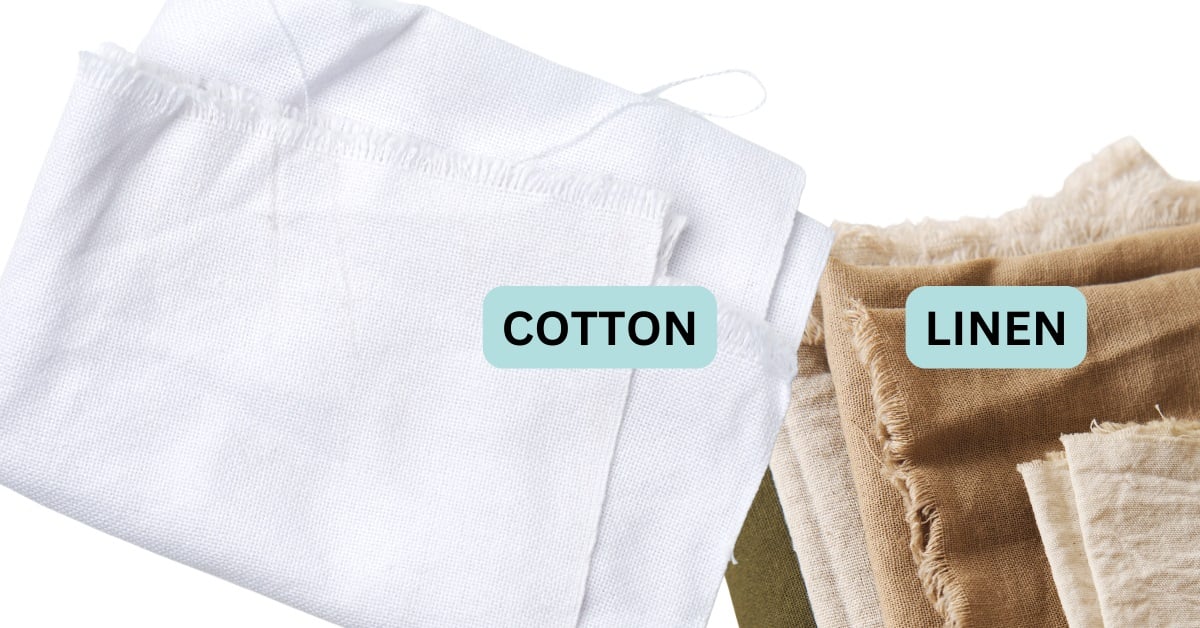French style has captivated fashion enthusiasts for decades. The effortless sophistication of Parisian wardrobes and the relaxed refinement of French homes share one secret: the right fabric choice.
Whether you’re crafting a capsule wardrobe inspired by French fashion or decorating your home with that coveted French aesthetic, the fabric you choose makes all the difference. Two materials stand out as favorites among French designers and style enthusiasts: cotton and linen.
This guide breaks down the key differences between these fabrics and helps you decide which one best suits your French-inspired projects. From texture and drape to durability and care, we’ll examine every aspect that matters for achieving that authentic French look.
Understanding French Style in Fashion & Home
French style centers around three core principles: simplicity, comfort, and timeless appeal. French women don’t follow fleeting trends. Instead, they invest in quality pieces that work season after season.
The French approach to fashion favors clean lines, neutral colors, and versatile silhouettes. Think crisp white shirts, well-tailored trousers, and flowing dresses in soft, muted tones. These pieces create a foundation that can be dressed up or down with minimal effort.
French home design follows similar principles. French interiors blend rustic charm with refined touches. Natural materials take center stage, creating spaces that feel both lived-in and polished. Soft textures, sustainable materials, and a connection to nature define the French home aesthetic.
Both fashion and interior design rely heavily on fabric choice. The right material can transform a simple shirt into a statement piece or turn a basic room into a sophisticated sanctuary.
Cotton Fabric Overview
Cotton offers versatility that few fabrics can match. This natural fiber feels soft against the skin while providing the structure needed for crisp, tailored pieces.
French designers often turn to specific cotton varieties for different looks. Cotton poplin creates those perfect button-down shirts that form the backbone of French wardrobes. Cotton voile works beautifully for flowing summer dresses and delicate blouses. Cotton cambric provides the smooth finish ideal for fine shirts and undergarments.
The breathable nature of cotton makes it comfortable for year-round wear. It holds its shape well, which is essential for achieving that polished French look. Cotton also accepts dyes beautifully, allowing for the rich, saturated colors that French fashion loves.
For home applications, cotton shines in bedding, curtains, and upholstery. Cotton sheets feel soft and inviting while maintaining their crisp appearance after washing. Cotton curtains provide privacy while filtering light beautifully.
One significant advantage of cotton is its ease of care. Most cotton fabrics can be machine washed and dried, making them practical for busy lifestyles. Cotton also irons well, allowing you to maintain that crisp, put-together appearance that defines French style.
Linen Fabric Overview
Linen brings a different energy to French style. This ancient fabric offers a relaxed luxury that perfectly captures the French art of living well.
The texture of linen sets it apart immediately. The slightly irregular weave creates visual interest and depth that catches the eye. Linen feels substantial yet lightweight, making it ideal for warm weather and relaxed occasions.
French designers particularly love linen for its ability to look effortlessly chic. A linen shirt or dress automatically conveys that casual sophistication that French style is known for. The fabric’s natural tendency to wrinkle actually adds to its charm, creating a lived-in look that feels authentic rather than overly polished.
Linen works exceptionally well in home decor. Linen curtains filter light beautifully while adding texture to windows. Linen bedding creates a relaxed, hotel-like atmosphere in bedrooms. Table linens in linen feel both casual and special, perfect for French-inspired dining.
The durability of linen is legendary. High-quality linen pieces can last for decades, actually improving with age as the fibers soften. This longevity aligns perfectly with French attitudes toward consumption and quality.
However, linen does require more careful handling than cotton. It wrinkles easily and often needs professional cleaning or careful hand washing to maintain its best appearance.
Cotton vs Linen: A Side-by-Side Comparison for French Style
When choosing between cotton and linen for French style projects, several factors come into play:
Texture and Feel: Cotton offers smoothness and softness, while linen provides texture and character. Cotton feels refined and polished, while linen feels relaxed and natural.
Drape and Fit: Cotton can be structured or flowing depending on the weave, making it versatile for different silhouettes. Linen naturally drapes in a relaxed way, creating effortless shapes that move beautifully with the body.
Ideal Applications: Cotton excels in shirts, blouses, and tailored pieces where structure matters. Linen shines in summer dresses, casual trousers, and home decor where texture adds interest.
Durability: Both fabrics are strong, but linen typically lasts longer. Cotton maintains its appearance consistently, while linen becomes softer and more beautiful with age.
Maintenance: Cotton wins for easy care. Most cotton items can be machine washed and dried. Linen requires more attention, often needing careful washing and air drying.
Seasonality: Cotton works year-round, adapting to different weights and weaves. Linen performs best in spring and summer when its breathable nature is most appreciated.
Sustainability: Both can be eco-friendly choices. Linen is naturally biodegradable and requires less water to produce. Organic cotton offers similar environmental benefits.
Cotton or Linen: Which Fabric Works Best for French Style?
The choice between cotton and linen depends on your specific goals and lifestyle needs.
For Everyday Parisian Looks: Cotton provides the structure and polish needed for classic French pieces. A cotton poplin shirt works equally well in the office and at weekend brunch. Cotton’s ability to hold crisp lines makes it perfect for achieving that put-together Parisian aesthetic.
For Riviera-Inspired Outfits: Linen captures the relaxed sophistication of French coastal living. Linen trousers and flowing dresses embody the effortless chic that defines French summer style. The fabric’s natural texture adds visual interest without trying too hard.
For Home Aesthetic: Both fabrics work beautifully in French-inspired interiors, but for different reasons. Linen adds the rustic texture that defines French country style. Cotton provides the refined comfort needed for French provincial looks.
For Sustainability: Both fabrics can be sustainable choices when sourced responsibly. Linen has a slight edge due to its lower water requirements and complete biodegradability.
For Busy Lifestyles: Cotton wins for practicality. If you need pieces that look polished with minimal effort, cotton’s easy care requirements make it the better choice.
Fabric Sourcing: Where to Buy Cotton and Linen
Quality fabric sourcing makes a significant difference in your finished projects. Several reliable suppliers offer both cotton and linen options suitable for French-style projects.
Buy fabric online from established suppliers for the best selection and quality. Many online retailers now offer detailed fabric descriptions and care instructions that help you make informed choices.
Fabriclore ships cotton and linen fabrics by the yard internationally, including to France. They offer custom prints and eco-certified options with low minimum orders, making them accessible for home sewers and small businesses.
Tissus.net provides a wide range of fabrics including GOTS-certified cotton and quality linen options. As an EU-based supplier, they offer convenient shipping to France and throughout Europe.
Mondial Tissus represents a local French option with both physical stores and online shopping. They carry extensive collections of both cotton and linen fabrics suitable for fashion and home projects.
Ma Petite Mercerie offers boutique fabric options perfect for French-style DIY projects and slow fashion initiatives. Their curated selection focuses on quality over quantity.
When choosing suppliers, look for certifications like GOTS (Global Organic Textile Standard) for cotton or OEKO-TEX standards for both fabrics. These certifications ensure the fabrics meet environmental and safety standards.
Making Your Choice: Cotton or Linen for French Style
Both cotton and linen have earned their place in French style for good reasons. Cotton provides the versatility and structure needed for classic French pieces, while linen offers the relaxed luxury that defines French living.
Consider cotton when you need reliable, easy-care pieces that maintain their appearance with minimal effort. Cotton works beautifully for structured shirts, tailored trousers, and home items that need regular washing.
Choose linen when you want to capture that effortless French charm. Linen clothing and home textiles bring texture, character, and that lived-in luxury that makes French style so appealing.
The best French-inspired wardrobes and homes often include both fabrics, using each where it performs best. A cotton shirt paired with linen trousers creates a perfect balance of structure and relaxation. Cotton bedding with linen curtains brings both comfort and style to bedrooms.
Focus on quality over quantity when making your fabric choices. Whether you choose cotton or linen, investing in well-made pieces from reputable suppliers ensures your French-inspired projects will look beautiful and last for years to come.
Explore Fabriclore’s extensive selection of custom printed, ready mill-dyed, and yarn-dyed fabrics—ideal for your next collection. For personalized assistance, contact us at [email protected]. Experience authentic, affordable, and seamless fabric sourcing.

